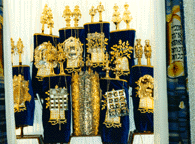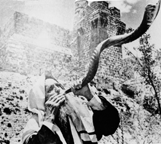
Yom Kippur or Day of Atonement is observed on the tenth day of Tishre (September-October) and represents a culmination of the Ten Days of Penitence which begins on Rosh Hashanah. The most solemn and important holiday in the Jewish year, Yom Kippur is characterized by fasting and prayer. While other holidays are often ignored by many secular Jews, Yom Kippur is typically observed even by the less-religious.

The laws concerning the observance of Yom Kippur are clearly outlined in the Jewish scriptures. According to the Bible, Jews are not permitted to work and must afflict their souls between the eve of the ninth and the eve of the tenth of Tishre. The actual laws concerning this affliction are given in the Halkakhah. Specifically, five things are forbidden on Yom Kippur: eating and drinking, washing oneself for personal grooming, the wearing of leather shoes, anointing the body, and conjugal relations. The punishment for indulging in these pleasures is said to be destruction. Children, pregnant women, and the sick are generally exempted from observing the laws of Yom Kippur.
 Jews are expected to attend five prayer services on Yom Kippur.
The first, which is held on the evening of the ninth of Tishre,
is known as Kol Nidre and serves to mark the beginning of the
holiday. Between the morning and the afternoon of the tenth of
Tishre, three services are held. The final service, known as Neilat
She'arim (Closing of the Gates) is characterized by the blowing
of the shofar. While the exact purpose
for sounding the shofar is unknown, it is generally believed to
signify the joyous nature of the end of Yom Kippur.
Jews are expected to attend five prayer services on Yom Kippur.
The first, which is held on the evening of the ninth of Tishre,
is known as Kol Nidre and serves to mark the beginning of the
holiday. Between the morning and the afternoon of the tenth of
Tishre, three services are held. The final service, known as Neilat
She'arim (Closing of the Gates) is characterized by the blowing
of the shofar. While the exact purpose
for sounding the shofar is unknown, it is generally believed to
signify the joyous nature of the end of Yom Kippur.
The principal element which characterizes prayer during the Day of Atonement is confession. Confessions are made once during the afternoon service on the ninth of Tishre and ten times during the holiday itself. In Judaism, Yom Kippur confessions are a very personal affair. Unlike in Catholicism, confessions are not given to clerics but rather are made silently. In addition, piyyutim prayers, particularly selihot and rahanim, which ask for forgiveness and mercy, are also important components of the Yom Kippur prayer services.

As on other holidays, specific portions of the holy scriptures are read on Yom Kippur. During the morning service, six people are called to read Leviticus 16. This is then followed by the reading of Isaiah 57:15-58:14 (Haftarah) and Numbers 29:7-11 (maftir). In the afternoon, Leviticus 18 (Torah) and the book of Jonah and Micah 7:18-20 (Haftarah) are recited.
 There are many customs associated with Yom Kippur. On the day
before Yom Kippur, people usually give money to tzedakah.
Some people also participate in ritual cleansing, known as a Minhah,
in the late afternoon. In recent years, it has been customary
to bless one's children on the eve of the day of Atonement.
There are many customs associated with Yom Kippur. On the day
before Yom Kippur, people usually give money to tzedakah.
Some people also participate in ritual cleansing, known as a Minhah,
in the late afternoon. In recent years, it has been customary
to bless one's children on the eve of the day of Atonement.
On the actual day of Yom Kippur, it is customary to light candles and to say a blessing over them. The prayers, the Amidah and parts of the Shema, which are normally read silently, are read aloud on this day. While it is not required, some individuals remain standing during all five prayer services.
| Back to Holidays | Glossary | Treasures | Life Cycle | Home Page |